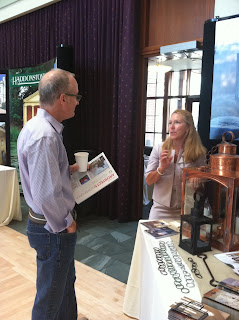
Even though it's a beautiful day to be outside in the sunshine for some folks, for us the place to be since early yesterday is the Traditional Building conference series in Boston, sponsored by Restore Media in conjunction with Institute of Classical Architecture.
Good afternoon, it's Rebecca Joslow reporting from Boston! This conference seems is a great place to meet new people who appreciate quality workmanship and products--we share lots of the same clients. I attended a meeting last night, where we discussed marketing strategies and what works for the niche work we are in. Some other sponsors in the meeting were custom cabinetry, windows, Victorian tiles, classical moldings, etc.
With this many professional together, naturally, the topic of marketing is a big one. What do clients want? How do they like to explore ideas and products? There was much discussion about google analytics, keywords, rankings and what becomes of all the gathered data. An architect (on the board of the Institute of Classical Architecture) mentioned that she hasn't touched a brochure in about five years. Does it always make more sense to go virtual? Another company owner explained the importance of 3D mock-ups for clients to visualize a space (lighting, time of day, color, proportion).
Throughout the lecture, he thoughtfully walked the audience through his process of urbanization. The system he uses is to "meaningfully engage citizens in the design of their community." What is responsible design? What does it mean to be socially conscious and aware of the environment around one's own self? Gindroz's three step process in regard to public engagement is a solution worthy of our attention.
The first step is Understanding, the second is Exploring and the third is Comparing. When approaching a design challenge, especially in low income or mixed-income areas, collaborative design is crucial. Feedback from the members of the community is the only way to move forward successfully. What is the situation? How can these problems be solved? What are a few possible solutions? He stressed the importance of staying silent during this practice, in order to refrain from editing a speaker's thoughts. Listen, listen, listen. During this process, an integral step is to "compare this input to the analysis of physical form", or in colloquial terms, build a model and provide more than one way to respond to the community's needs. Actually, not a bad model for problem solving generally.
With all of that in mind, sustainability is the future of design and plays a reigning role in both material choices and architectural design throughout the whole process. The next step is to explore and try out the some ideas. After the preliminary research is done and thought out, the only thing left to do is deciding what to do. Gindroz emphasized the importance of maintaining a designed space's "local identity in an age of mass production", something that, of course, means a great deal to us and our fellow attendees.
He refers back to books and old floor plans to understand the simplicity and complexity of the area. From there, he implements the influence of design guidelines from plans to details and images and from both classical and contemporary sources. After working out the details, he goes back to the community and surrounding areas for their input. How do the surrounding area feel about these changes? Using the tools for humane urbanism, he makes the impact of physical form on people's lives. How do they flow throughout the space? Does it enhance their experience of life and reflect who they are "inside"? Gindroz posed an interesting question, which is highly personal and difficult to achieve in projects such as mass housing. He approaches dwelling as a mirror of the self by questioning "who we are in society" and having a sense of self image within a space. The personality and architecture must work hand in hand. Then and only then is the most personal and meaningful urban design accomplished. Ray Gindroz's talent in keying into the soul of a project keeps him in the forefront of the architectural world.






